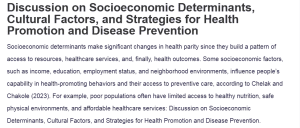Discussion on Socioeconomic Determinants, Cultural Factors, and Strategies for Health Promotion and Disease Prevention
Socioeconomic determinants make significant changes in health parity since they build a pattern of access to resources, healthcare services, and, finally, health outcomes. Some socioeconomic factors, such as income, education, employment status, and neighborhood environments, influence people’s capability in health-promoting behaviors and their access to preventive care, according to Chelak and Chakole (2023). For example, poor populations often have limited access to healthy nutrition, safe physical environments, and affordable healthcare services: Discussion on Socioeconomic Determinants, Cultural Factors, and Strategies for Health Promotion and Disease Prevention.
Moreover, education is related to health literacy, which determines the level of knowledge about disease prevention behaviour and compliance with medical recommendations. These disparities indicate targeted interventions that must be developed to address the root causes of inequities in resource distribution and access to health care.
Notably, cultural and historical issues also shape the health behaviours of different populations. Examples include the distrust in health care founded on historical injustices, such as the Tuskegee Syphilis Study, which still influences healthcare utilization among African Americans, according to Frazier, (2020).
Cultural beliefs and practices influence health behaviours regarding food preference, reliance on traditional medicine, and attitudes towards vaccination. For instance, some cultural groups may prioritize alternative healing practices, which can delay seeking professional medical care (Stubbe, 2020). Addressing these factors requires a culturally sensitive approach that respects individuals’ beliefs while promoting evidence-based practices.
Besides, some strategies for promoting health and preventing disease in diverse populations that healthcare providers can use include culturally tailored education programs that relate to and are accessible to the population. Community health workers can teach nutrition in communities in a language and culture specific to the audience.
Second, as suggested by Haleem et al. (2021), providers can use telemedicine and other technology to expand preventive services in rural or remote communities. Finally, there needs to be a building of trust through community involvement and transparency. That may include community health fairs at no charge or even sponsorship of local, credible leaders who promote health information.
References
Chelak, K., & Chakole, S. (2023). The role of social determinants of health in promoting health equality: A narrative review. Cureus, 15(1), 1–8. https://doi.org/10.7759/cureus.33425
Frazier, C. (2020). It’s More than Just news: Print media, the Tuskegee Syphilis Study and Collective Memory among African Americans. Journal of Historical Sociology, 33(3). https://doi.org/10.1111/johs.12281
Haleem, A., Javaid, M., Singh, R. P., & Suman, R. (2021). Telemedicine for healthcare: Capabilities, features, barriers, and Applications. Sensors International, 2(2), 100–117. https://doi.org/10.1016/j.sintl.2021.100117
Stubbe, D. E. (2020). Practicing cultural competence and cultural humility in the care of diverse patients. Focus, 18(1), 49–51. https://doi.org/10.1176/appi.focus.20190041
ORDER A PLAGIARISM-FREE PAPER HERE
We’ll write everything from scratch
Question 
In preparation for this discussion, review Chapter 1 and Chapter 12 of the textbook. These chapters will help you differentiate between health promotion and disease prevention. Additionally, these readings will provide information related to social determinants of health and the impact providers can have on diverse populations. As you address the prompts below, think about the Principles Underlying a Culture of Health on page 20. Consider what makes health care efficient and equitable (aka: health parity).
Textbook: Health Promotion in Nursing Practice, 8th edition. ISBN: 9780134754086
- Describe how socioeconomic determinants affect health parity in the promotion of health and disease prevention.
- Discuss a cultural or historical factor that may impact health behaviors among a diverse population.
- What strategies can healthcare providers employ to promote health and prevent disease among diverse populations? Give specific examples.
Reminder: For each of the discussions, you have a discussion board rubric that identifies how your work will be graded. To view this Rubric, before submitting your work, simply select the drop box menu (three dots on the top right of this page) and “Show Rubric.”

Discussion on Socioeconomic Determinants, Cultural Factors, and Strategies for Health Promotion and Disease Prevention
Scholarly Sources: Only scholarly sources are acceptable for citation and reference in this course. These include peer-reviewed publications, government reports, or sources written by a professional or scholar in the field. For the discussions, reputable internet sources such as websites by government agencies (URL ends in .gov) and respected organizations (often ends in .org) can be counted as scholarly sources.